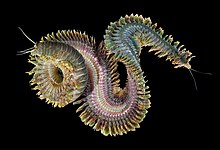Alitta virens
| Alitta virens | |
|---|---|

| |
| Scientific classification | |
| Domain: | Eukaryota |
| Kingdom: | Animalia |
| Phylum: | Annelida |
| Clade: | Pleistoannelida |
| Subclass: | Errantia |
| Order: | Phyllodocida |
| Family: | Nereididae |
| Genus: | Alitta |
| Species: | A. virens
|
| Binomial name | |
| Alitta virens | |
| Synonyms[1] | |
| |
Alitta virens (
scientific names, including Nereis virens, are still frequently used) is an annelid worm that burrows in wet sand and mud. They construct burrows of different shapes (I,U,J and Y) [2] They range from being very complex to very simple. Long term burrows are held together by mucus. Their burrows are not connected to each other; they are generally solitary creatures. The spacing between the burrows depends on how readily they can propagate water signals.[2]
It was first described by biologist Michael Sars in 1835.[3] It is classified as a polychaete in the family Nereididae.[1]
Sandworms make up a large part of the live sea-
overharvesting before the worms are able to reproduce by spawning.[citation needed] Sandworms are also very essential to the study of the investigation of metal uptake in marine biology.[5] They are vital to evaluate the effects of metals in marine organisms.[6]
Sandworms eat
microorganisms. Sandworms are known to be omnivores. Their diet consists of surface sediment, plant and animal remains. They are oftentimes exposed to metals through their diet and their burrowing tactics.[5]
They have many distinctive traits, including:
- often reaching great lengths, sometimes exceeding four feet
- They are large in size (approximately 30 cm more or less) [5]
- Sandworms are abundant in European coasts and fiord environments.[5]
- They dominate fully saline coastal areas and have large distribution along with large biomass.[6]
- numerous, highly vascularized parapodiaalong both sides of their bodies
- blue heads with two large pincer teeth which are capable of biting humans[7]
The parapodia function both as external gills (the animal's primary respiratory surfaces), and as means of locomotion (appearing much like short legs).[citation needed]
Usually, sandworms are
metanephridia gland.[8]
Gallery
References
- ^ heterotypic synonym
- ^ S2CID 87480544.
- ^ "Alitta virens (M. Sars, 1835)". World Register of Marine Species.
- from the original on 2012-04-26.
- ^ S2CID 201658793.
- ^ PMID 33164845.
- ^ "King Ragworm". BritishSeaFishing.co.uk. July 2012. Retrieved 24 January 2014.
- ^ "Alitta virens (Sars, 1835)". SeaLifeBase. Retrieved 30 November 2021.






